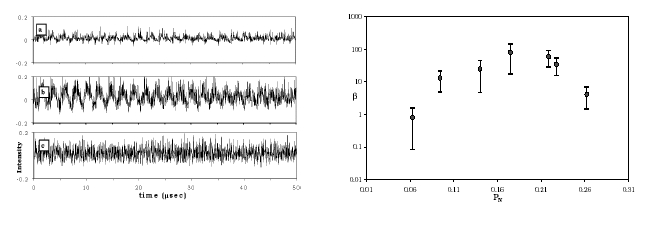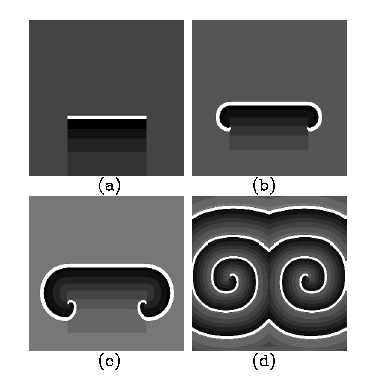|
Nonlinear Optics and Laser Physics:
Coherence
Resonance and Excitability in Optical Systems
Coherence
Resonance in Optical Systems
This program researches through experiment and theory the phenomena of
noise induced ordering of the temporal behaviour of nonlinear systems. In contrast with linear systems, for
which noise normally reduces their regular output characteristics, in
nonlinear systems the effect of noise may paradoxically result in increased
coherence, amplification, signal-to-noise ratio as well as new more ordered
regimes or structures. Coherence
Resonance (CR) is a new phenomenon, which has been recently shown to
underlie such behaviour. In optics evidence of this has recently been
observed in a laser diode with optical feedback by imposing noise on this
system. More generally in nonlinear
optics there are however many interactions in which noise is an intrinsic
initiating process from which deterministic and ordered behaviour
evolves. Stimulated scattering is a
paradigm of such interactions, though the mechanisms by which such
transitions take place have so far been largely unresolved.
In recent work our experimental observation of the phenomenon of CR in
stimulated Brillouin scattering (SBS), excited in an optical fibre with
very weak feedback, provide first evidence of CR in an autonomous noise
generating process. The scattered
signal displays stochastic dynamic behaviour from its onset. On increase of the pump signal a window
of periodicity appears, emerging from and subsequently subsiding into the
stochastic emission, dependent on the strength of the stochastic signal
(see Figures). These characteristic
features of CR are currently being researched through coherency analysis of
experimental time series data of the scattered emission and substantiated
through numerical modeling. Our
findings provide a first clue to the origin of determinism of SBS as being
a manifestation of order submerged within noise, brought out through
CR.They are the basis on which this program is currently being extended to
research other nonlinear processes in optics to determine universality of
the phenomenon of coherence resonance in noise initiated nonlinear
interactions.

Figure 1(left): Dynamic component
of the Stokes signal at pump levels 2Pth (a), 4Pth (b), and 7Pth (c). The vertical axis is Stokes intensity for
each pump level in relative units (Pth is threshold pump power for SBS).
Figure 2 (right): Measure of coherence versus noise power. Dots are mean coherence and the error
bars are one standard deviation.
Excitability
in Optical Systems
Excitability has long been studied as an important class of dynamical
phenomenon in biological and chemical systems. In local regions, an excitable system
exhibits a long excursion (pulse) in phase space for a super-threshold
perturbation, the magnitude and width of such a pulse being independent of
this perturbation. For spatially
extended systems, excitability underlies wave propagation and formations,
such as cardiac muscle and nerve wave fronts and spirals under the
FitzHugh-Nagumo model and chemical excitation waves in the
Belousov-Zhabotinsky reaction.
However, it is only recently that excitable features have been
revealed in nonlinear systems that have physical mechanisms different from those
of biological and chemical interactions, such as in liquid crystals and
most recently an injected laser.
In our recent work, we have established an optical cavity containing
two-level medium to be excitable. We
show that its excitable behaviour occurs in a small parameter window close
to a bistable operating region and is attributable to the combined
dynamical effects of nonlinear intracavity field saturation and
temperature-dependent field absorption in the medium on two different time
scales. We argue that such
excitability may be experimentally realized in popular optical bistable
devices. Possible applications of
optical excitability are discussed.
For a spatially extended system, we have shown that finite external
excitation can lead to a travelling wave in one-dimensional transverse
space. We have studied the excitable
behaviour of this system inn parallel with that of its diffusive
counterpart and shown the effect s of optical phase on the travelling-wave
solution and its velocity. In
two-dimensional space we have observed numerically rotating optical spiral
waves evolving from a truncated wave front.

Figure: Evolution of a truncated
wavefront to spirals in spatially extended 2D optical system.
Back to Research Reviews'
Page
|